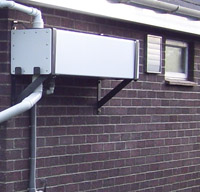Dec 23 2008
Environmental engineering company and water expert MWH is working with Dwr Cymru Welsh Water and manufacturers Aqualogic, to produce affordable wall-mounted rainwater harvesting systems that can be fitted to homes to reduce water consumption and down stream flooding.

The initiative is part of the ongoing £800,000 ‘Surface Water Management Strategy’ that aims to reduce the amount of surface water flows that enter the sewers in Wales, and is led by Huw Jones from MWH’s office at Llanishen, Cardiff.
Huw explains: “As part of the Surface Water Management Strategy we are developing a low cost, low tech rainwater harvesting system that will reduce the amount of rainwater entering the sewage system. The water collected will initially be used only for toilet flushing, but this may be extended for garden watering and other external uses that don’t require water of drinking quality.
“We have teamed up with one of Welsh Water’s water efficiency partners Aqualogic, who are designing, testing and manufacturing a series of prototypes at their base in the Wirral, Merseyside. The first of the prototypes has been installed at Cilfynydd sewage treatment works and educational centre in South Wales.”
The lessons learned from the initial trial will be used to inform a larger scale trial. Work is also being undertaken with the Centre for Research into Environment and Health at Aberystwyth University to ensure that any potential public health issues associated with this system are fully explored.
Commenting on the system, Aqualogic Director Ben Rice said: “For the first four weeks of installation the equipment will be monitored to see how much rainwater it can harvest, with observations made as to the level of contaminants in the collected water. After this period the system will be plumbed into a WC along with potable (drinking) water to enable it to be used to flush toilets. The system will then be monitored to measure how it reduces water use, however there are technical hurdles to overcome relating to water regulation and water hygiene prior to use outside our controlled environments.”
Principal Engineer Dave Brook from MWH’s Cardiff office has developed the principles behind the system. “Our work suggests that for the target property to which such a system would be fitted, a typical three bedroom terraced house in South Wales, significant savings in the water supplied can be achieved, with relatively small storage tanks.
Short payback time makes system attractive
“Using a small tank size means that the flexible modular system can be wall-mounted, avoiding the need for expensive groundworks and complicated pumping and control systems. For a metered property the average pay back time on such a system should be less than five years.
“This short payback time, which compares favourably with other green technologies such as solar panels or wind turbines, along with the low cost of installation, should mean the system will prove attractive to water customers in Wales and have an impact on down stream flooding incidents.”
Commenting on the project Dave Bayliss of Welsh Water said: “We believe that reducing the quantities of surface water that enter the combined sewerage system is vital, and a rainwater harvesting strategy can be a key part of this, while at the same time reducing customers’ bills.”